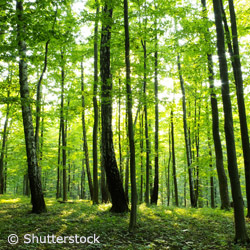Researchers re-examine water policy focus
Although the world's forests supply a significant amount of moisture that creates rain, the important contribution they make to the water cycle is often overlooked in water resource policy. This is the conclusion of a new study published by Swedish and Hungarian researchers in the journal Global Change Biology. The pan-European team warn that reducing forest area reduces regional and continental rainfall. One of the team members, David Ellison from the Hungarian Academy of Sciences, comments: 'Are forests good for water? An apparently simple question divides scientists in two camps - those who see trees as demanding water and those who see trees as supplying water. This paper demonstrates that the difference between these two camps has to do with the spatial scale being considered. Forests, whose contribution to the water cycle is crucial for human survival and future well being, should be regarded as a global public good, to be preserved and used for the benefit of all.' From a local perspective, a tree acts as a consumer of water; on a broader scale, however, trees supply the atmosphere with moisture that will then become rainfall. Some dry areas depend almost entirely on rain that comes from forest-covered areas via the atmosphere. At the moment, though, it is the first interpretation of trees - as water consumers - that forms the basis of much legislation, such Directive 2000/60/EC, the EU's Water Framework Directive (WFD) which includes strategies for water pricing. This directive does not yet consider the contribution forests make to the water cycle. If forests continue to decline, there is a risk that both rainfall and water supply will decrease in many places. Adapting to these changing circumstances will require reforestation strategies to bring about increasing precipitation to regions where rainfall is declining. Urbanisation, progressive deforestation, and land conversion from forest to agriculture all have potentially negative consequences for global precipitation. This study suggests that policymakers should consider the link between forests and the supply of precipitation when estimating the value of ecosystem services, promoting afforestation, developing drought mitigation strategies, managing land use and measuring 'water footprints'. The water footprint is an indicator of water use that looks at both direct and indirect water use of a consumer or producer. The water footprint of an individual, community or business is defined as the total volume of fresh water that is used to produce the goods and services consumed by the individual or community, or produced by the business. Early European water legislation began in 1975 with the setting of standards for rivers and lakes used for drinking water abstraction, followed in 1980 by the setting of binding quality targets for drinking water. It also included quality objective legislation on fish waters, shellfish waters, bathing waters and groundwater. Its main emission control element was Directive 76/464/EEC, the Dangerous Substances Directive. European water policy has undergone a thorough restructuring process, and the WFD adopted in 2000 set the objectives for water protection for the future. However, as it stands, forests are only mentioned once in the WFD, and forestry is not mentioned at all, despite its potential implications for streams, rivers and lakes. The team found that in Europe, the principal focus of afforestation strategies has been either on the carbon sequestration potential of forests or on their value as sources of bioenergy. Their potential use as an adaptation tool, in particular for promoting increased precipitation and combating drought, has been greatly underemphasised.For more information, please visit: Expertanswer:http://www.expertsvar.se/english/
Countries
Sweden

